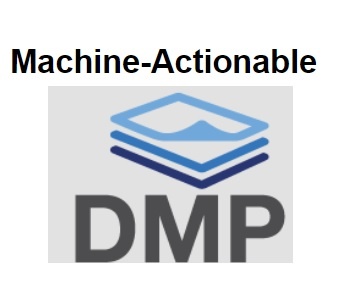Machine-actionable Data Management Plans (maDMPs): Connecting the dots or...The Journey of a DMP
31/08/2018

What are maDMPs? What are they not? Who are they for? How are they different from “traditional” DMPs? What does this mean for the future of DMPs and support services? …What comes next?

(Source: DMP Tool)
|
“RESEARCH DATA: Data are facts, observations or experiences on which an argument or theory is constructed or tested. Data may be numerical, descriptive, aural or visual. Data may be raw, abstracted or analysed, experimental or observational. Data include but are not limited to: laboratory notebooks, field notebooks, primary research data (including research data in hardcopy or in computer readable form), questionnaires, audiotapes, videotapes, models, photographs, films, test responses. Research collections may include slides, artefacts, specimens, samples“, - LEARN Glossary |
Machine-Actionable DMPs (maDMPs) are a vehicle for reporting on the intentions and outcomes of a research project that enable information exchange across relevant parties and systems.
They contain an inventory of key information about a project and its outputs (not just data), with a change history that stakeholders can query for updated information about the project over its lifetime. The basic framework requires common data models for exchanging information, currently under development in the RDA DMP Common Standards WG, as well as a shared ecosystem of services that send notifications and act on behalf of humans.
Other components of the vision include machine-actionable policies, persistent identifiers (PIDs) (e.g., ORCID iDs, funder IDs, forthcoming Org IDs, RRIDs for biomedical resources, protocols.io, IGSNs for geosamples, etc), and the removal of barriers for information sharing.

Related:
- Connecting the dots: Creating a joined up approach to Data Management Plans (Research Services at The University of Manchester Library)
- Data management made simple
- Data Management Plan for projects at the University of Vienna. Recommended Repository: Phaidra (V2.0/customised for UNIVIE) (English): Version 2.0
- Research data: life cycle and ARCHIVING (University of Portsmouth)
- Managing personal data
- Example of Research ethics approval process (which includes all research involving people)
- Erasmus University’s Privacy Impact Assessment (PIA) route planner is not only rather beautiful, it also makes a lot of sense
- Welcome to Open Data Management in Agriculture and Nutrition Online Course
- GDPR & What It Means For Researchers (recorded LIBER webinar, 2018)
- What and Why FAIR data? Easier said than implemented?
- Recorded ORCID Webinar : Enter once | Reuse often: What does this mean to research institutions?
- It’s Time to Build a Cohesive Data Strategy
- HPE Data Management Framework: Making storage bigger on the inside
- Frictionless Data and FAIR Research Principles
- Providing researchers with access to the DATA MANAGEMENT tools they need (UK Data Service)
- METADATA 2020 : details and crosswalks of the recommendations. Can we agree?
- Shaking up the value chain : Data and digitization are creating a growing array of value-creation choices in industries as diverse as pharmaceuticals, mining, and energy

You are welcome to Sign up for AIMS News, follow @AIMS_Community on Twitter... And, thanks again for your interest !
